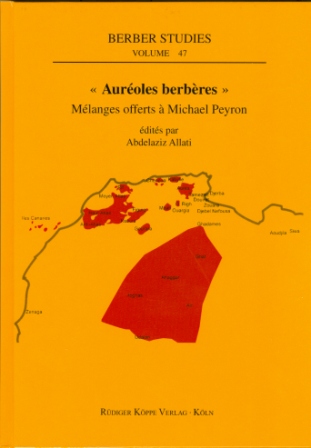


Michael Peyron (*1935) is a specialist in the field of Berber (especially Amazigh) language, literature and culture. He is equally known as a writer about tourism in Morocco. Born in the United Kingdom, he studied in France (Bordeaux and Grenoble). His doctoral thesis was about an Amazigh region in the mountains of High Atlas in Morocco. Peyron taught at the faculty of letters at the University Mohammed V in Rabat (1973–1988) and at the Department of English at Grenoble University (1988–1995). In the late 1980s, the focus of his career switched from English to Amazigh studies.
From 1995 to 1997, he became a visiting professor at the King Fahd School of translation (Tanger, Morocco) and since 1997, he is a visiting professor at Al Akhawayn University in Ifrane. He has been teaching Amazigh culture and language. The publications of Michael Peyron are numerous. Among his eminent works are two bilingual poetry volumes in French and Tamazight and a collection of fables in Tamazight and English. Since 1985, he has been contributing to the forthcoming Tamazight encyclopedia.
CONTENTS
Présentation
Principales publications de Michael Peyron
Littérature et chanson
Amar Ameziane: Lwali n wedrar – entre legende hagiographique et fiction romanesque
Fatima Boukhris: Mohamed Rouicha et les sonorités du Maroc pluriel
Bassou Hamri: La poésie amazighe de la résistance
Hachem Jarmouni: Les proverbes amazighes – l’univers culturel connoté ; essence et évanescence
Nadia Kaaouas: La mémoire du conte berbère
Mohand Akli Salhi: Littérarité et qualification de la parole littéraire – explorations des représentations langagières kabyles
Miloud Taïfi: De la promotion poétique – de quelques objets anodins
Codification, traduction, didactique et anthroponymie
Mahmoud Amaoui: Quelques éléments de réflexions sur le transfert de l’alphabet latin au berbère aux XVIIIe et XIXe siècles
Amar Ameziane: Remarques sur une traduction d’un poème kabyle
Ouahmi Ould-Braham: Aux origines de l’enseignement du berbère à l’École supérieure des Lettres d’Alger (de 1880 à 1900)
Patrice Pognan: Un nouvel horizon pour le dictionnaire raisonné berbère-français – parlers du Maroc : l’élaboration d’une méthode d’apprentissage
Ouerdia Yermeche: Quelques éléments d’anthroponymie kabyle – les surnoms
Linguistique
Abdalaziz Allati: La dérivation dans la morphologie berbère
Fatsiha Aoumer: De la deixis et du mécanisme de la référence en berbère (parler des Iɛemranen (Toudja, Béjaïa)
Karim Bensoukas: No schwas in Amazigh open syllables – Why the mismatch?
Ramdane Boukherrouf: Les fonctions anaphoriques de l’indice de personne en berbère (kabyle)
Moha Ennaji: Berber language and colloquial Arabic in contact – A case of language revitalization
Maarten Kossmann: Personal pronouns in the Ayt Seghrushen Berber variety of the province of Taza
Jilali Saib: Isaffen Ghbanin as language documentation for Amazigh linguistic studies
Mohamed Serhoual: Tamazight et l’emprunt
Gábor Takács: Some Berber etymologies IX
Andrzej Zaborski: Language resistance movement
Under these links you will find publications by Michael Peyron and the complete text of the review by Daniela Merolla.
© 2026 by Rüdiger Köppe Verlag – www.koeppe.de